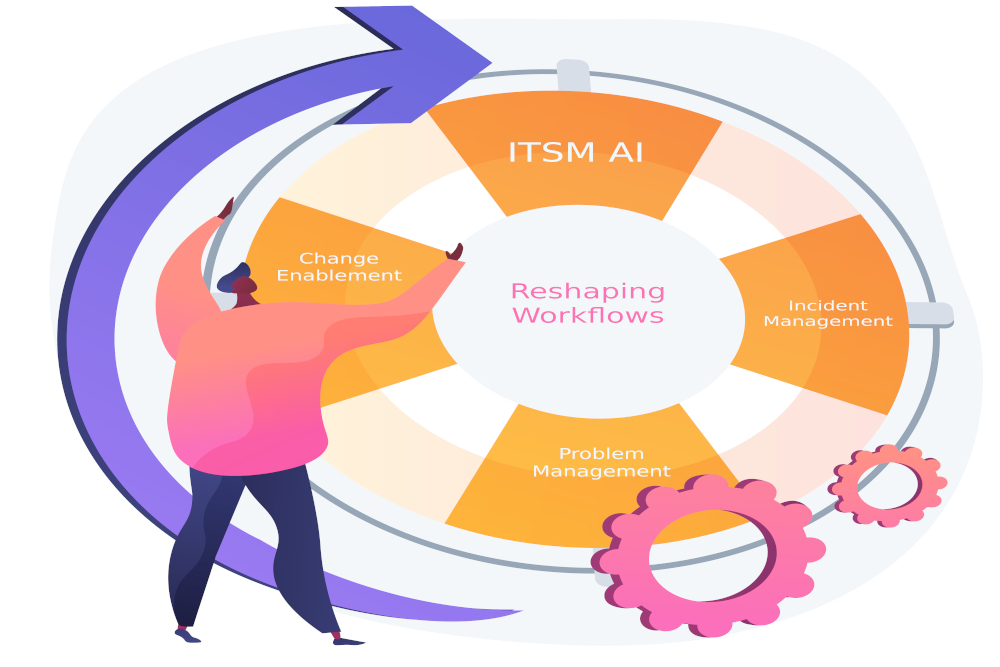Every IT leader I speak with wants AI to move their teams from firefighting to foresight. The promise is compelling, fewer outages, lower costs, faster resolutions. Yet most pilots stall, not because the AI fails, but because the ITSM processes around it stay frozen in old habits.
When people talk about moving from reactive IT to proactive operations with AI, it often sounds effortless. The reality is different. The real challenge is not the tools or the models but the way IT Service Management (ITSM) processes are aligned to absorb and act on what AI delivers. This is the core of itsm ai and where most organisations stumble.
What makes process alignment the sticking point?
Technology on its own can flag patterns, highlight risks, and recommend fixes. That does not mean value will be realised. If the surrounding processes do not evolve to accommodate these insights, AI ends up sitting on the sidelines.
Lets look at a few practical scenarios.
- Recurring incidents. AI can surface patterns across tickets, but unless Problem Management acts on those signals, the cycle repeats and staff remain stuck firefighting. The difficulty is that many organisations have scaled back or sidelined Problem Management, treating it as an afterthought or shared responsibility. Without a clear owner, AI insights risk being noticed but never acted on.
- Predicted outages. Anomaly detection can warn of potential system stress, but if Change Enablement is not structured to act on these predictions, the risk remains unaddressed. In reality, many Change teams are already stretched, managing a heavy flow of planned changes with limited resources. Adding proactive, AI-driven changes on top can overwhelm capacity, which means predicted risks may be logged but not acted on in time.
- Knowledge assistants. AI tools can recommend relevant articles to analysts and end-users, but if the Knowledge process does not actively govern and refresh the content, the recommendations lose credibility. Many organisations struggle here because Knowledge Management is often under-resourced, very messy and treat improvement as low-priority work. The result is stale or incomplete articles, which quickly erodes trust in AI-driven suggestions.
Each of these shows that AI cannot replace ITIL’s definition of service management practices. Instead, it changes how those practices operate, making them more dynamic and tightly coupled with real-time signals.
Why this matters for AI service management

So, it is clear that for ai service management to succeed, processes like Incident, Problem, and Change must be modernised, not discarded. AI outputs should trigger workflows automatically, but with checks that align to governance and compliance expectations.
This is not about layering AI on top of old processes. It is about reshaping workflows so that predictive insights and automated classifications fit naturally into how work is tracked and resolved. For example, many organisations still close tickets manually without validation. In an AI-driven environment, closure confirmation could be automated, but must still be governed by the same accountability rules.
Modernising these processes means making deliberate changes.
- Incident Management needs clear rules for when AI can classify, route, or even close tickets. Safeguards must exist to prevent bad data flowing downstream.
- Problem Management must take ownership of the recurring patterns AI identifies, rather than leaving them as “nice to know” insights. This requires dedicated capacity and accountability.
- Change Enablement has to adapt so predicted outages or risks from AI can trigger preventative change models. That means introducing fast-track pathways while still respecting compliance.
Basically, the foundation of ITSM remains, but the way it interacts with data and automation needs to be rewritten. Without this effort, AI will surface insights that look promising but never translate into action. With it, IT moves closer to proactive operations where service management processes and AI work hand in hand.
A consultant’s perspective and what this looks like in practice
I have visited several organisations that have tried to implement AI in ITSM without revisiting their process design often to find adoption stalls after the pilot. The dashboards look impressive, the models run, but the service desk continues to operate as before.
I’ve seen one enterprise deploy AI-driven incident routing, yet service desk staff overrode the AI because categorisation rules were outdated. The technology was not at fault. The lack of process alignment was.
Another IT team tried predictive maintenance for critical systems. The AI was correct about rising risk, but Change processes were so slow and risk-averse that no action was taken in time. Again, the issue was not the model but the process.
This to me underlined a simple point. AI magnifies the strengths or weaknesses of the processes it touches. If ITSM is mature, AI accelerates results. If ITSM is fragmented, AI compounds the confusion.
What needs to change inside ITSM processes

- Incident Management must include AI-driven categorisation and routing as standard practice, not as an optional add-on.
- Problem Management should treat AI pattern analysis as a primary input, building actions into regular reviews.
- Change Enablement has to evolve to handle predictive alerts quickly, otherwise AI-driven risk detection achieves little.
- Knowledge Management must be actively governed, ensuring AI assistants have accurate content to share.
These are not technology projects. They are process redesign projects with AI integrated at key decision points.
Where the gains will actually show up
The 2025 “State of AI in IT” report shows that 61% of IT professionals expect cost reduction as the main benefit of AI in ITSM. Yet the same research reveals only 29% have realised those savings so far. The gap comes from weak process integration.
Real gains appear when AI is built into the operating model and that includes…
- Shorter mean time to resolution because tickets flow to the right team without delay.
- Lower operational costs as recurring problems are tackled upstream instead of downstream.
- Better user experience when AI assistants provide answers that are validated and governed by the knowledge process.
This is how you move from pilots that look good on paper to measurable improvements in service quality and cost efficiency.
The technology is already here. What will set leaders apart is whether they can adjust their ITSM processes to absorb AI outputs meaningfully. Those who treat process alignment as the main project, not the afterthought, will see real results from AI in service management.
FAQ Questions
How does AI reduce incident response time in ITSM?
AI automates ticket classification and routing, sending issues to the right resolver groups immediately. This eliminates delays caused by manual triage and mis-categorisation.
What are the limitations of AI in service management?
AI depends heavily on clean, structured data. If tickets are poorly documented or service maps are missing, predictions and recommendations are often inaccurate.
Do ITIL processes still matter in an AI-driven ITSM model?
Yes, ITIL’s definition of service practices remains essential. AI enhances how processes like Incident, Problem, and Change operate but does not replace the need for governance and structure.
What are examples of AI service management in action?
Common examples include AI chatbots handling basic service requests, predictive alerts for system health, and automated knowledge recommendations during incident resolution.
